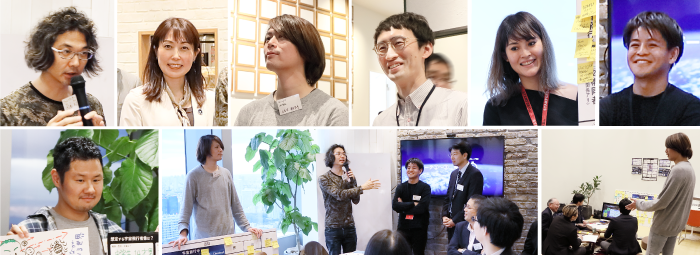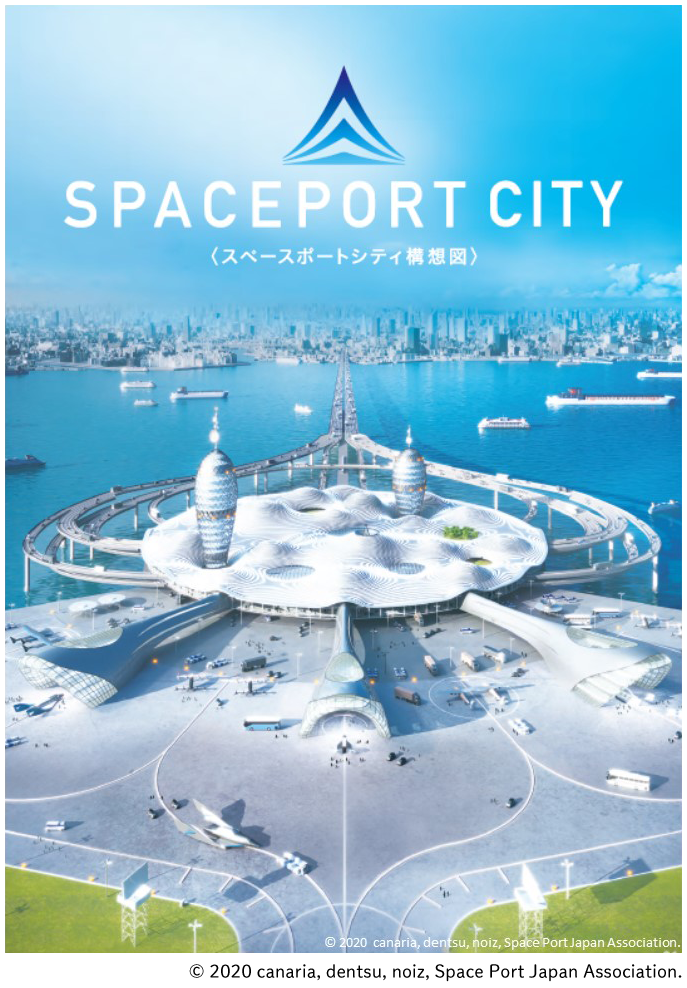Did you know a project is currently underway to build a "spaceport" in Japan where manned spacecraft will take off and land? Last time, we provided an overview of this project.
What kind of spaceport should we build?
How will the surrounding city develop around the spaceport?
As the first step in giving shape to the spaceport, Space Port Japan (SPJ), the general incorporated association driving this project, and Dentsu Inc. gathered various companies and organizations for a workshop. They compiled the ideas generated there and announced the "Spaceport City Concept Map" in June.
This time, we feature Shunichi Katayama and Naoko Yamazaki, who launched SPJ, along with Akihito Kunimi from Dentsu Inc. Business Design Square, who facilitated the workshop. They shared insights into the workshop process and their passion for the Spaceport City Concept.
Making Japan the Hub for Space Tourism Business in Asia
Katayama: This is an all-Japan effort to build a spaceport in Japan. That said, many people still aren't familiar with SPJ, the organization we founded. So, first, we need to introduce ourselves.
Yamazaki: SPJ is an organization established in 2018. We collaborate with domestic and international companies, organizations, and government agencies to build a spaceport in Japan capable of handling manned spacecraft. Currently, over 40 companies, local governments, and university research labs are members participating in the project.
While Japan has already launched numerous satellites via rockets, no manned spacecraft have flown yet. When we launched SPJ two years ago, there was a sense of urgency. While companies like Virgin Galactic and SpaceX in other countries are nearing the final stages of developing their rockets and spacecraft, proposing concepts like "connecting various countries quickly using spacecraft," Japan's infrastructure development is lagging behind. By establishing multiple spaceports in Japan, we aim for Japan to become a hub for space tourism and point-to-point transportation business in Asia.
Katayama: Both in Japan and overseas, the space industry is booming right now, with rockets being launched one after another by private companies. Interest in this project is growing, and SPJ has attracted participation from a wide range of companies and organizations beyond the aerospace sector, including real estate firms and insurance companies.
Yamazaki: This is a unique aspect specific to Japan. While the US and Europe have many space industry consortia, perhaps because their aerospace industries are more developed, these tend to be highly specialized within that sector. Of course, many venture companies are involved, and M&A and technology exchange are active, but cases where unrelated industries participate are still relatively rare. In contrast, Japan's approach—building networks centered around space-related companies while also involving people from diverse fields—feels like a significant strength that will grow stronger.
Kunimi: The workshop we held this time also saw participation from a wide range of industries, and ideas we hadn't imagined kept emerging one after another. To broaden the scope of ideas, participants first set aside their company titles and envisioned, as individuals, how they would like to spend time at a spaceport. After various ideas surfaced, they then considered what businesses or services could be developed based on their own company's operations.
Katayama: Everyone seemed to really enjoy themselves, passionately presenting their ideas right up until the time limit, and there was lively discussion.
Kunimi: We conducted the workshop in two steps. In the first step, we asked them to imagine "what kind of people would come to the spaceport." Of course, people going on space travel would come, but family and friends seeing them off would also visit. So, specifically, what kind of people would they be?
The next step focused on the theme: "How will people who visit the spaceport spend their time?" No one comes just for launch day. So, we asked them to consider how visitors would spend the three days: the day before launch, launch day itself, and the day after.
By designing the spaceport to be a hub where various activities unfold around the core experience of "going to space," we can create new industries centered on this venue. We turned each visitor's actions into a story, then refined the details: What actual services and facilities would be needed? Which companies would provide them?
Katayama: We generated many ideas, didn't we? The workshop made me realize the diverse ways space travel could exist and the numerous industries that could emerge from it. It was a huge learning experience for me personally. Kunimi, what stood out most to you?
Kunimi: What I found fascinating was a team that envisioned a "middle school student going to space as part of an elite education program, carrying their parents' expectations," and then considered how that child would spend their time at the spaceport.
That made me think: perhaps we'll see the emergence of people who could be called "space people." What I mean is, a generation ago, people working across borders were called "global citizens." As environmental issues gained attention, terms like "global citizens" started being used.
As explained in the previous article, spaceports serve not only as "bases for going to space" but also as "bases for traveling to other places on Earth." For example, they can be used to travel between two points on Earth, like from Tokyo to Los Angeles. Launching a spaceplane from a runway and gaining altitude to approach space means air resistance is virtually eliminated, allowing flight at speeds many times faster than an airplane. You'd travel from Tokyo to Los Angeles via space.
In the future, people who go to space or travel via space will undoubtedly be called "aliens." And I felt that people who have been to space must have their perspectives, ideas, and ways of thinking fundamentally changed.
Yamazaki: You're absolutely right. When I think back to my time in space, at night I could clearly see the border between South Korea, which was brightly lit, and North Korea, which was pitch black. Or the border between India and Pakistan, where the security lights were constantly on. The Earth is one celestial body, yet sadly, I felt how nations can sometimes be divided.
The crew members on the International Space Station come from different countries, and everyone has different opinions and positions. It wasn't easy to understand each other, but even so, I felt like we were "sitting in the same boat." I wondered if going to space might spread that kind of awareness to more people.
Kunimi: We also discussed how one might feel seeing nations fighting from space. Going to space probably does allow you to see things from a more bird's-eye perspective than we have now.
That's why a spaceport needs to be a place where people can truly learn this "space perspective." It shouldn't just be a fun place; it should also be a place where various research takes place.
Katayama: Mr. Yamazaki, you've always been at the heart of the space industry. How did you feel about collaborating across different industries in the workshop to develop a single concept?
Yamazaki: What was truly impressive was that everyone focused on specific characters rather than just broad concepts. They defined protagonists who would use the spaceport, like "retirees wanting to enjoy space travel" or "party-loving people." By delving into how each of these individuals would actually spend their time at the spaceport, the ideas expanded in surprising ways.
Spaceports will become places visited by all kinds of people, from children to adults, encompassing diverse activities. I sensed the potential for jobs we can't even imagine yet to emerge here, making it a truly attractive destination.
Bringing the "Spaceport City Concept" to Life
Katayama: A particularly noteworthy aspect of this workshop was that we didn't just share the concept internally and call it done. We created a pamphlet and announced it to the world as the "Spaceport City Concept Diagram."
■ "Spaceport City Concept Map" (Complete Version)
https://www.spaceport-japan.org/concept
Kunimi: A summary at the report level would eventually fade away. That would be a tremendous waste. This workshop wasn't about fantasizing about the future; it was about creating a blueprint for the future.
The pamphlet was designed to present the Spaceport City as if it already existed. Our aim was for people to see it and feel the immediacy and certainty of this future, making it real to them.
We also wanted to convey that the spaceport isn't just a place for space travel; it will eventually become a crossroads for various industries and evolve into something even greater.
Yamazaki: Looking at the concept diagram really struck me. I had been thinking of it as an extension of an "airport." But the brochure cover shows the entire "city." A waterfront area, with the spaceport and the city connected by a highway.
The city concept diagram encompassing the entire urban area had a powerful impact. Looking at this overall picture, it really sparks your imagination—making you think, "Wouldn't it be great to live here?" or "Wouldn't it be wonderful to work nearby?"
Kunimi: Having visuals really adds to the realism. That's why we enlisted the help of canaria and noiz, experts in architecture and design, to create it.
Katayama: Spaceports often feel distant and unrelated to the average person. But seeing a concrete brochure—one that feels like it could actually exist—makes people perceive it as something relevant to them. We want to use this brochure as a foundation to advance this concept to the next phase.
We want to grow our team and realize the Spaceport City concept.
Kunimi: We want to increase the number of companies and organizations participating in this project. What we do to achieve that is crucial. To turn this vision into reality, not just a dream, we need to integrate it into the operations and businesses of various companies. It must be sustainable.
I believe we can gain more supporters by evolving this concept diagram—making it more tangible through this pamphlet, creating videos people can casually watch on their phones, and sparking discussions about the spaceport in various settings among diverse people.
Yamazaki: One of SPJ's goals is to "develop the aerospace industry," but this industry has an incredibly broad scope. Space is essentially a "platform." Unlike specific technologies like robotics or AI, it's about what you do there – the possibilities are vast.
That's precisely why, as Kunimi-san said, we need to expand our community. If we pursue what's outlined in the pamphlet to its fullest, it encompasses entertainment, housing, food, and clothing – everything is connected. There are possibilities like cutting-edge medical care or rehabilitation in space.
The image isn't exactly the Sagrada Familia, but rather something built incrementally, evolving step by step. The spaceport itself needs to be attractive and magnetic, becoming a place where diverse people gather. Ideally, it would serve as the gateway to the space environment.
Kunimi: Both Mr. Yamazaki and I are from the generation that grew up dreaming of the Space Battleship Yamato, right? Many people have always wanted to go to space, and that dream gave rise to astronauts like Mr. Yamazaki.
But perhaps ours might be the last generation to hold such a deep fascination with space. In the not-too-distant future, saying "I'm going to space" might spark a conversation like, "This weekend?" That's precisely why being able to go to space now is such an incredibly exciting, joyful era.
Katayama: That's an interesting perspective. The Spaceport City concept isn't some distant future from old sci-fi stories anymore—it's the near future. I believe we're rapidly entering the phase where it becomes reality. We want to build momentum toward making it happen, gaining widespread support and creating a hub where various industries intersect.











